HI6006 - Strategic Management: Analysis of Development Tools
VerifiedAdded on 2023/06/13
|7
|1722
|73
Essay
AI Summary
This essay provides an overview of strategic development tools used by organizations to succeed in their target markets. It focuses on three key tools: PESTEL analysis, Porter's Five Forces, and the Resource-Based View (RBV). PESTEL examines the macro-environmental factors (Political, Economic, Social, Technological, Environmental, and Legal) that can influence a business. Porter's Five Forces analyzes industry rivalry, threat of substitutes, bargaining power of buyers and suppliers, and the threat of new entrants. The Resource-Based View focuses on a company's internal resources and capabilities, categorizing them as tangible and intangible, and evaluating them based on VRIO (Value, Rarity, Imitability, and Organization) attributes to gain a competitive advantage. The essay concludes that these tools are essential for making informed strategic decisions and achieving a competitive edge in the market.
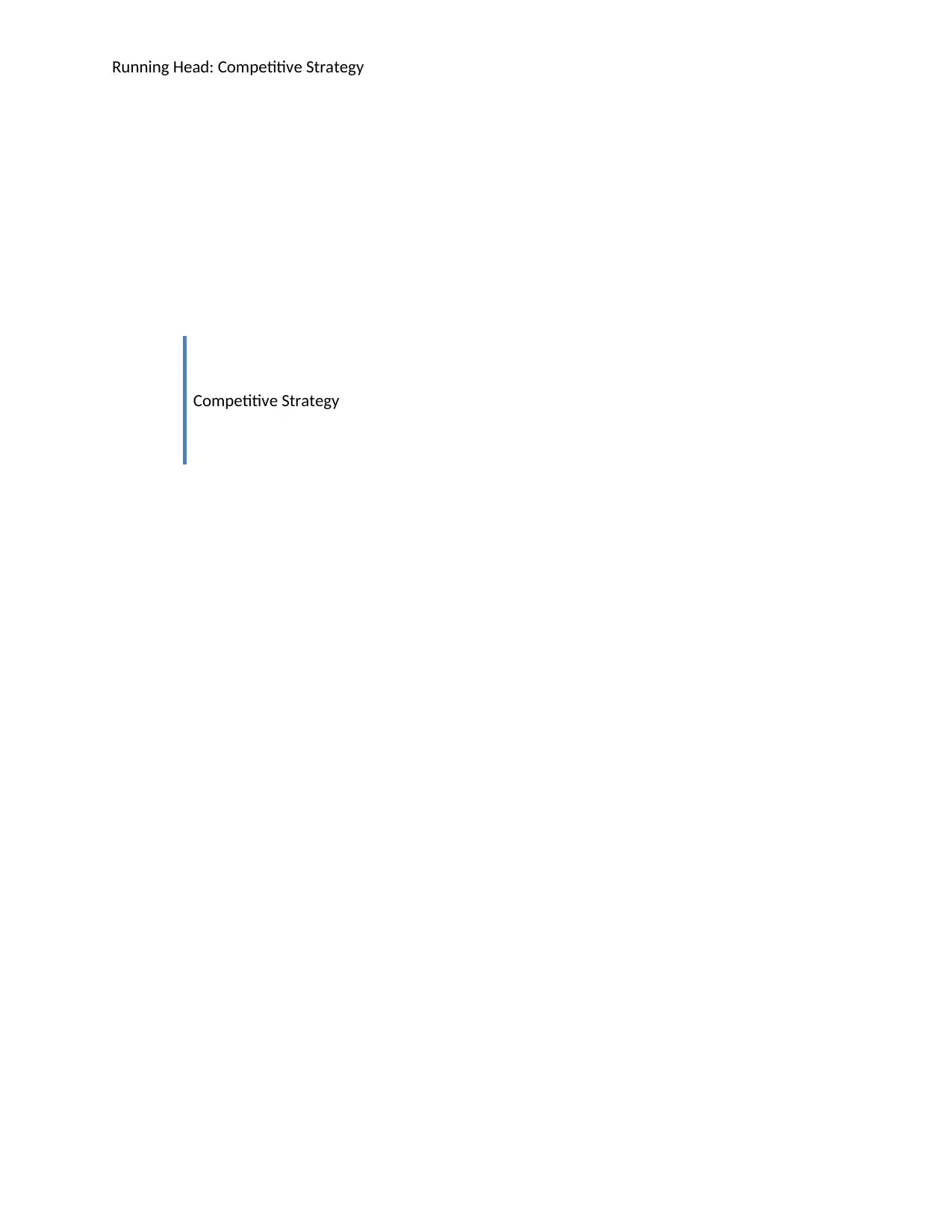
Running Head: Competitive Strategy
Competitive Strategy
Competitive Strategy
Paraphrase This Document
Need a fresh take? Get an instant paraphrase of this document with our AI Paraphraser
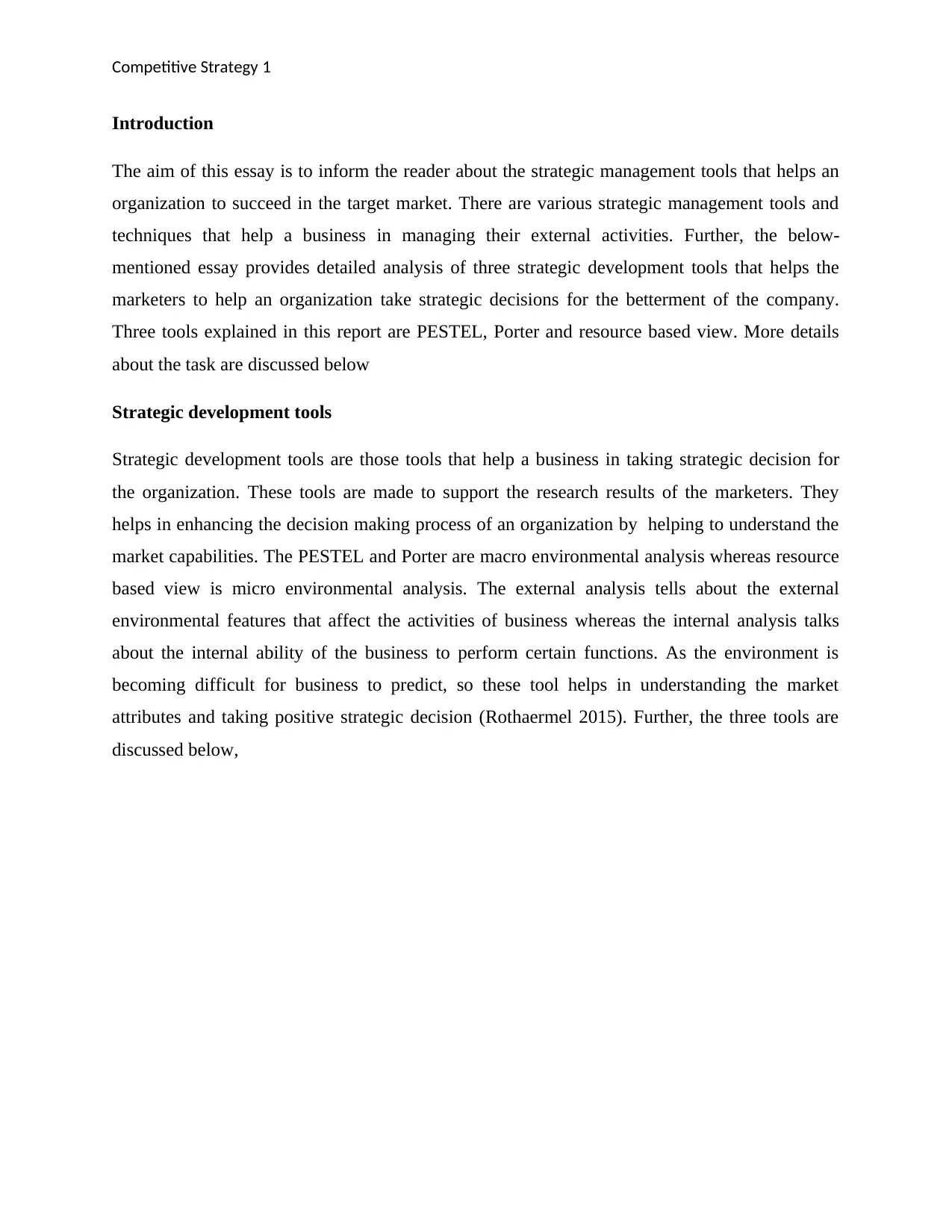
Competitive Strategy 1
Introduction
The aim of this essay is to inform the reader about the strategic management tools that helps an
organization to succeed in the target market. There are various strategic management tools and
techniques that help a business in managing their external activities. Further, the below-
mentioned essay provides detailed analysis of three strategic development tools that helps the
marketers to help an organization take strategic decisions for the betterment of the company.
Three tools explained in this report are PESTEL, Porter and resource based view. More details
about the task are discussed below
Strategic development tools
Strategic development tools are those tools that help a business in taking strategic decision for
the organization. These tools are made to support the research results of the marketers. They
helps in enhancing the decision making process of an organization by helping to understand the
market capabilities. The PESTEL and Porter are macro environmental analysis whereas resource
based view is micro environmental analysis. The external analysis tells about the external
environmental features that affect the activities of business whereas the internal analysis talks
about the internal ability of the business to perform certain functions. As the environment is
becoming difficult for business to predict, so these tool helps in understanding the market
attributes and taking positive strategic decision (Rothaermel 2015). Further, the three tools are
discussed below,
Introduction
The aim of this essay is to inform the reader about the strategic management tools that helps an
organization to succeed in the target market. There are various strategic management tools and
techniques that help a business in managing their external activities. Further, the below-
mentioned essay provides detailed analysis of three strategic development tools that helps the
marketers to help an organization take strategic decisions for the betterment of the company.
Three tools explained in this report are PESTEL, Porter and resource based view. More details
about the task are discussed below
Strategic development tools
Strategic development tools are those tools that help a business in taking strategic decision for
the organization. These tools are made to support the research results of the marketers. They
helps in enhancing the decision making process of an organization by helping to understand the
market capabilities. The PESTEL and Porter are macro environmental analysis whereas resource
based view is micro environmental analysis. The external analysis tells about the external
environmental features that affect the activities of business whereas the internal analysis talks
about the internal ability of the business to perform certain functions. As the environment is
becoming difficult for business to predict, so these tool helps in understanding the market
attributes and taking positive strategic decision (Rothaermel 2015). Further, the three tools are
discussed below,
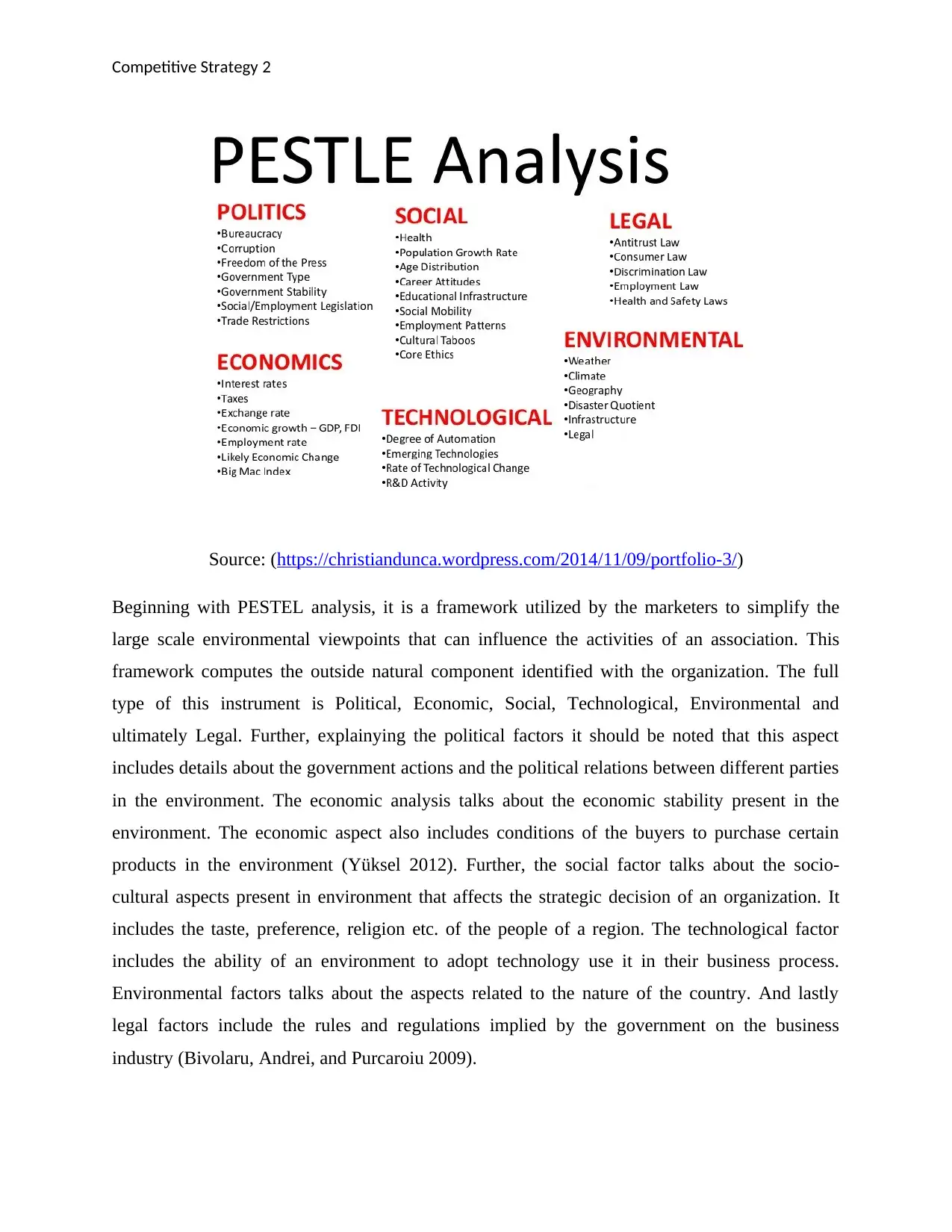
Competitive Strategy 2
Source: (https://christiandunca.wordpress.com/2014/11/09/portfolio-3/)
Beginning with PESTEL analysis, it is a framework utilized by the marketers to simplify the
large scale environmental viewpoints that can influence the activities of an association. This
framework computes the outside natural component identified with the organization. The full
type of this instrument is Political, Economic, Social, Technological, Environmental and
ultimately Legal. Further, explainying the political factors it should be noted that this aspect
includes details about the government actions and the political relations between different parties
in the environment. The economic analysis talks about the economic stability present in the
environment. The economic aspect also includes conditions of the buyers to purchase certain
products in the environment (Yüksel 2012). Further, the social factor talks about the socio-
cultural aspects present in environment that affects the strategic decision of an organization. It
includes the taste, preference, religion etc. of the people of a region. The technological factor
includes the ability of an environment to adopt technology use it in their business process.
Environmental factors talks about the aspects related to the nature of the country. And lastly
legal factors include the rules and regulations implied by the government on the business
industry (Bivolaru, Andrei, and Purcaroiu 2009).
Source: (https://christiandunca.wordpress.com/2014/11/09/portfolio-3/)
Beginning with PESTEL analysis, it is a framework utilized by the marketers to simplify the
large scale environmental viewpoints that can influence the activities of an association. This
framework computes the outside natural component identified with the organization. The full
type of this instrument is Political, Economic, Social, Technological, Environmental and
ultimately Legal. Further, explainying the political factors it should be noted that this aspect
includes details about the government actions and the political relations between different parties
in the environment. The economic analysis talks about the economic stability present in the
environment. The economic aspect also includes conditions of the buyers to purchase certain
products in the environment (Yüksel 2012). Further, the social factor talks about the socio-
cultural aspects present in environment that affects the strategic decision of an organization. It
includes the taste, preference, religion etc. of the people of a region. The technological factor
includes the ability of an environment to adopt technology use it in their business process.
Environmental factors talks about the aspects related to the nature of the country. And lastly
legal factors include the rules and regulations implied by the government on the business
industry (Bivolaru, Andrei, and Purcaroiu 2009).
⊘ This is a preview!⊘
Do you want full access?
Subscribe today to unlock all pages.

Trusted by 1+ million students worldwide
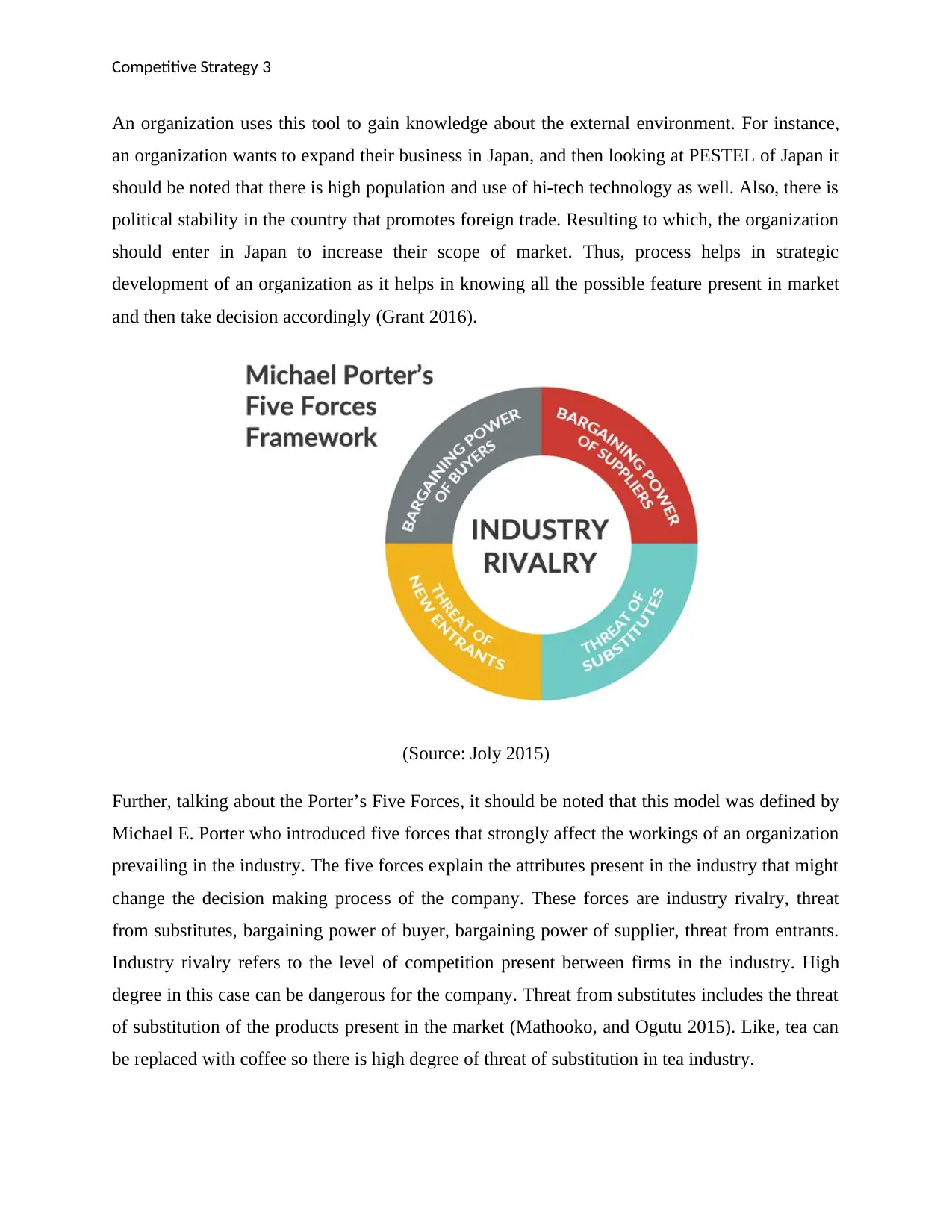
Competitive Strategy 3
An organization uses this tool to gain knowledge about the external environment. For instance,
an organization wants to expand their business in Japan, and then looking at PESTEL of Japan it
should be noted that there is high population and use of hi-tech technology as well. Also, there is
political stability in the country that promotes foreign trade. Resulting to which, the organization
should enter in Japan to increase their scope of market. Thus, process helps in strategic
development of an organization as it helps in knowing all the possible feature present in market
and then take decision accordingly (Grant 2016).
(Source: Joly 2015)
Further, talking about the Porter’s Five Forces, it should be noted that this model was defined by
Michael E. Porter who introduced five forces that strongly affect the workings of an organization
prevailing in the industry. The five forces explain the attributes present in the industry that might
change the decision making process of the company. These forces are industry rivalry, threat
from substitutes, bargaining power of buyer, bargaining power of supplier, threat from entrants.
Industry rivalry refers to the level of competition present between firms in the industry. High
degree in this case can be dangerous for the company. Threat from substitutes includes the threat
of substitution of the products present in the market (Mathooko, and Ogutu 2015). Like, tea can
be replaced with coffee so there is high degree of threat of substitution in tea industry.
An organization uses this tool to gain knowledge about the external environment. For instance,
an organization wants to expand their business in Japan, and then looking at PESTEL of Japan it
should be noted that there is high population and use of hi-tech technology as well. Also, there is
political stability in the country that promotes foreign trade. Resulting to which, the organization
should enter in Japan to increase their scope of market. Thus, process helps in strategic
development of an organization as it helps in knowing all the possible feature present in market
and then take decision accordingly (Grant 2016).
(Source: Joly 2015)
Further, talking about the Porter’s Five Forces, it should be noted that this model was defined by
Michael E. Porter who introduced five forces that strongly affect the workings of an organization
prevailing in the industry. The five forces explain the attributes present in the industry that might
change the decision making process of the company. These forces are industry rivalry, threat
from substitutes, bargaining power of buyer, bargaining power of supplier, threat from entrants.
Industry rivalry refers to the level of competition present between firms in the industry. High
degree in this case can be dangerous for the company. Threat from substitutes includes the threat
of substitution of the products present in the market (Mathooko, and Ogutu 2015). Like, tea can
be replaced with coffee so there is high degree of threat of substitution in tea industry.
Paraphrase This Document
Need a fresh take? Get an instant paraphrase of this document with our AI Paraphraser
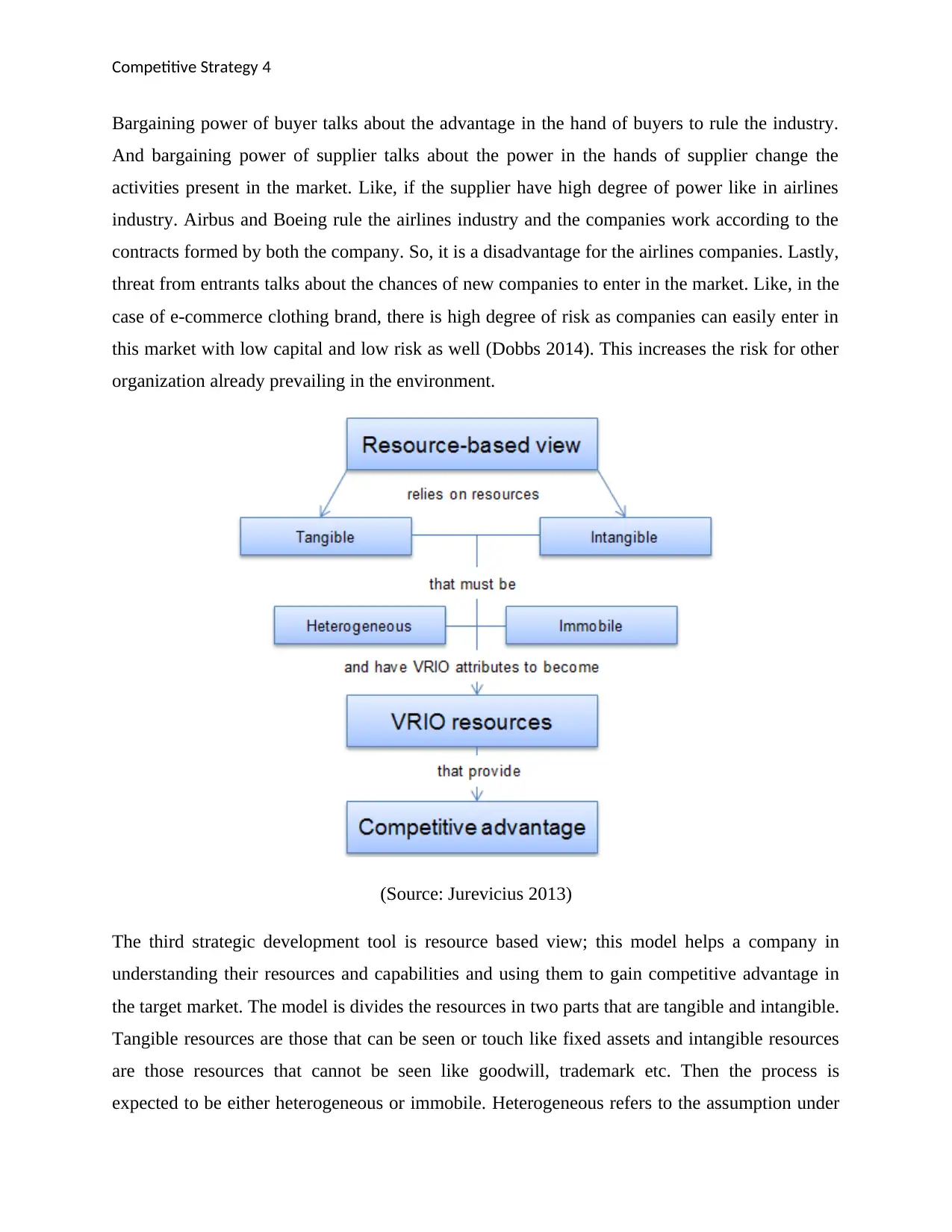
Competitive Strategy 4
Bargaining power of buyer talks about the advantage in the hand of buyers to rule the industry.
And bargaining power of supplier talks about the power in the hands of supplier change the
activities present in the market. Like, if the supplier have high degree of power like in airlines
industry. Airbus and Boeing rule the airlines industry and the companies work according to the
contracts formed by both the company. So, it is a disadvantage for the airlines companies. Lastly,
threat from entrants talks about the chances of new companies to enter in the market. Like, in the
case of e-commerce clothing brand, there is high degree of risk as companies can easily enter in
this market with low capital and low risk as well (Dobbs 2014). This increases the risk for other
organization already prevailing in the environment.
(Source: Jurevicius 2013)
The third strategic development tool is resource based view; this model helps a company in
understanding their resources and capabilities and using them to gain competitive advantage in
the target market. The model is divides the resources in two parts that are tangible and intangible.
Tangible resources are those that can be seen or touch like fixed assets and intangible resources
are those resources that cannot be seen like goodwill, trademark etc. Then the process is
expected to be either heterogeneous or immobile. Heterogeneous refers to the assumption under
Bargaining power of buyer talks about the advantage in the hand of buyers to rule the industry.
And bargaining power of supplier talks about the power in the hands of supplier change the
activities present in the market. Like, if the supplier have high degree of power like in airlines
industry. Airbus and Boeing rule the airlines industry and the companies work according to the
contracts formed by both the company. So, it is a disadvantage for the airlines companies. Lastly,
threat from entrants talks about the chances of new companies to enter in the market. Like, in the
case of e-commerce clothing brand, there is high degree of risk as companies can easily enter in
this market with low capital and low risk as well (Dobbs 2014). This increases the risk for other
organization already prevailing in the environment.
(Source: Jurevicius 2013)
The third strategic development tool is resource based view; this model helps a company in
understanding their resources and capabilities and using them to gain competitive advantage in
the target market. The model is divides the resources in two parts that are tangible and intangible.
Tangible resources are those that can be seen or touch like fixed assets and intangible resources
are those resources that cannot be seen like goodwill, trademark etc. Then the process is
expected to be either heterogeneous or immobile. Heterogeneous refers to the assumption under
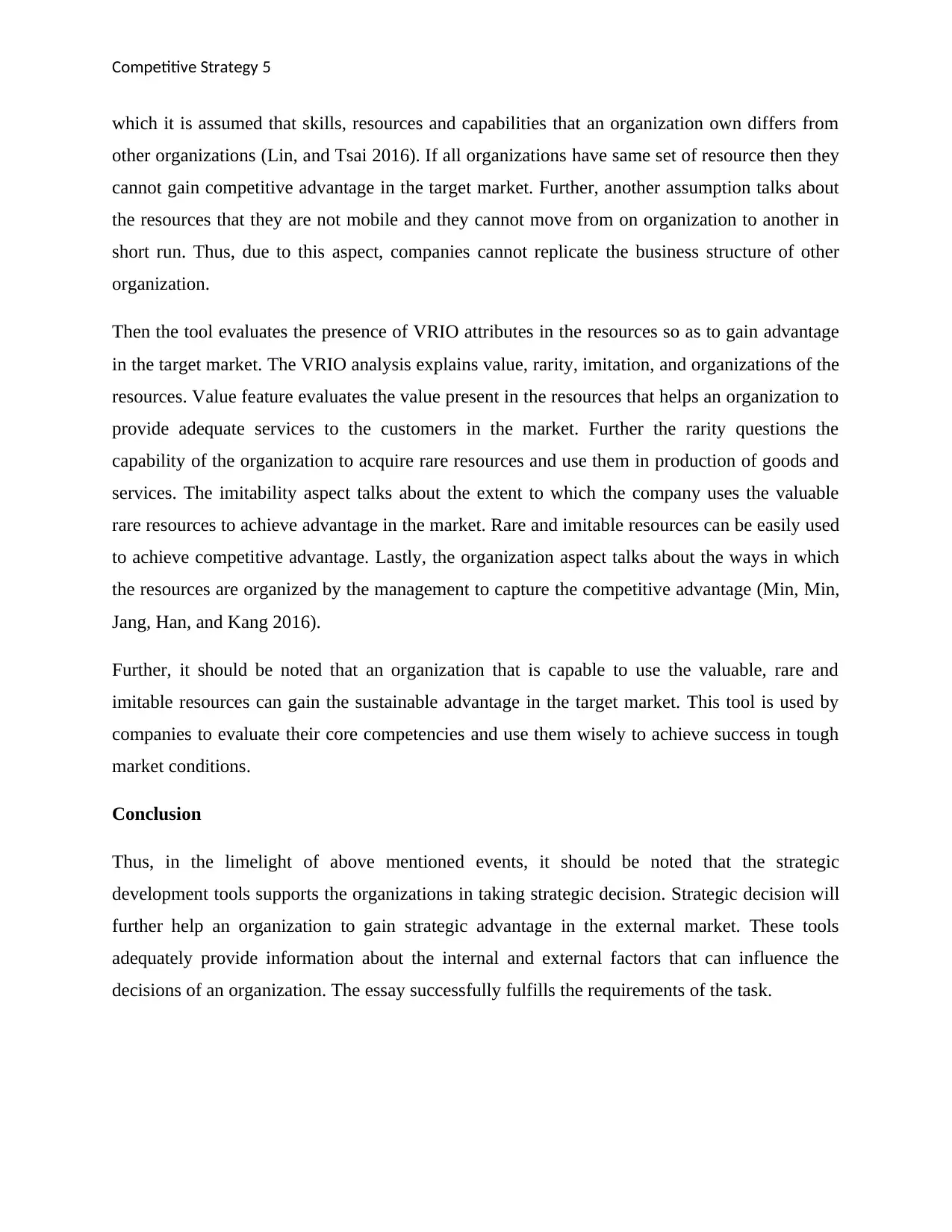
Competitive Strategy 5
which it is assumed that skills, resources and capabilities that an organization own differs from
other organizations (Lin, and Tsai 2016). If all organizations have same set of resource then they
cannot gain competitive advantage in the target market. Further, another assumption talks about
the resources that they are not mobile and they cannot move from on organization to another in
short run. Thus, due to this aspect, companies cannot replicate the business structure of other
organization.
Then the tool evaluates the presence of VRIO attributes in the resources so as to gain advantage
in the target market. The VRIO analysis explains value, rarity, imitation, and organizations of the
resources. Value feature evaluates the value present in the resources that helps an organization to
provide adequate services to the customers in the market. Further the rarity questions the
capability of the organization to acquire rare resources and use them in production of goods and
services. The imitability aspect talks about the extent to which the company uses the valuable
rare resources to achieve advantage in the market. Rare and imitable resources can be easily used
to achieve competitive advantage. Lastly, the organization aspect talks about the ways in which
the resources are organized by the management to capture the competitive advantage (Min, Min,
Jang, Han, and Kang 2016).
Further, it should be noted that an organization that is capable to use the valuable, rare and
imitable resources can gain the sustainable advantage in the target market. This tool is used by
companies to evaluate their core competencies and use them wisely to achieve success in tough
market conditions.
Conclusion
Thus, in the limelight of above mentioned events, it should be noted that the strategic
development tools supports the organizations in taking strategic decision. Strategic decision will
further help an organization to gain strategic advantage in the external market. These tools
adequately provide information about the internal and external factors that can influence the
decisions of an organization. The essay successfully fulfills the requirements of the task.
which it is assumed that skills, resources and capabilities that an organization own differs from
other organizations (Lin, and Tsai 2016). If all organizations have same set of resource then they
cannot gain competitive advantage in the target market. Further, another assumption talks about
the resources that they are not mobile and they cannot move from on organization to another in
short run. Thus, due to this aspect, companies cannot replicate the business structure of other
organization.
Then the tool evaluates the presence of VRIO attributes in the resources so as to gain advantage
in the target market. The VRIO analysis explains value, rarity, imitation, and organizations of the
resources. Value feature evaluates the value present in the resources that helps an organization to
provide adequate services to the customers in the market. Further the rarity questions the
capability of the organization to acquire rare resources and use them in production of goods and
services. The imitability aspect talks about the extent to which the company uses the valuable
rare resources to achieve advantage in the market. Rare and imitable resources can be easily used
to achieve competitive advantage. Lastly, the organization aspect talks about the ways in which
the resources are organized by the management to capture the competitive advantage (Min, Min,
Jang, Han, and Kang 2016).
Further, it should be noted that an organization that is capable to use the valuable, rare and
imitable resources can gain the sustainable advantage in the target market. This tool is used by
companies to evaluate their core competencies and use them wisely to achieve success in tough
market conditions.
Conclusion
Thus, in the limelight of above mentioned events, it should be noted that the strategic
development tools supports the organizations in taking strategic decision. Strategic decision will
further help an organization to gain strategic advantage in the external market. These tools
adequately provide information about the internal and external factors that can influence the
decisions of an organization. The essay successfully fulfills the requirements of the task.
⊘ This is a preview!⊘
Do you want full access?
Subscribe today to unlock all pages.

Trusted by 1+ million students worldwide
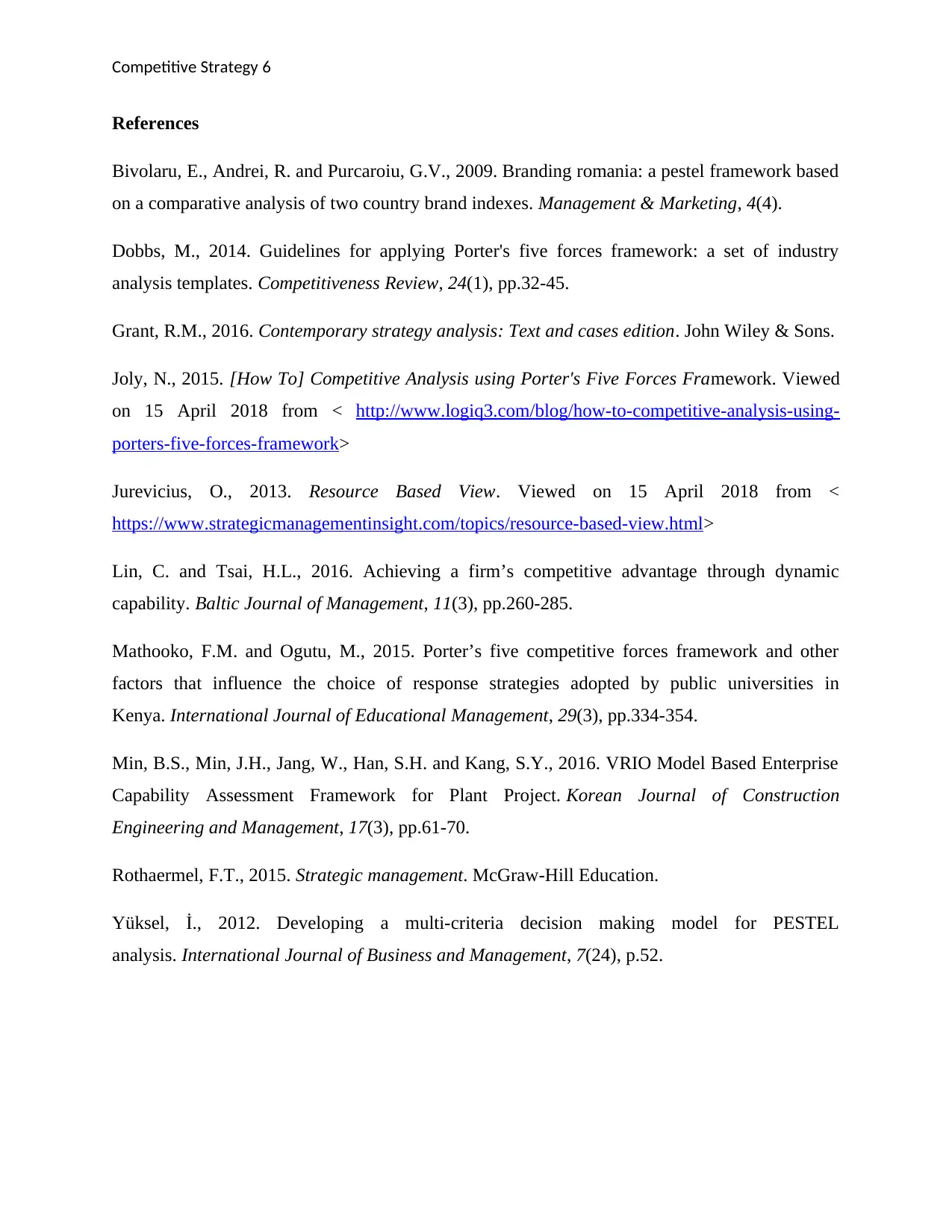
Competitive Strategy 6
References
Bivolaru, E., Andrei, R. and Purcaroiu, G.V., 2009. Branding romania: a pestel framework based
on a comparative analysis of two country brand indexes. Management & Marketing, 4(4).
Dobbs, M., 2014. Guidelines for applying Porter's five forces framework: a set of industry
analysis templates. Competitiveness Review, 24(1), pp.32-45.
Grant, R.M., 2016. Contemporary strategy analysis: Text and cases edition. John Wiley & Sons.
Joly, N., 2015. [How To] Competitive Analysis using Porter's Five Forces Framework. Viewed
on 15 April 2018 from < http://www.logiq3.com/blog/how-to-competitive-analysis-using-
porters-five-forces-framework>
Jurevicius, O., 2013. Resource Based View. Viewed on 15 April 2018 from <
https://www.strategicmanagementinsight.com/topics/resource-based-view.html>
Lin, C. and Tsai, H.L., 2016. Achieving a firm’s competitive advantage through dynamic
capability. Baltic Journal of Management, 11(3), pp.260-285.
Mathooko, F.M. and Ogutu, M., 2015. Porter’s five competitive forces framework and other
factors that influence the choice of response strategies adopted by public universities in
Kenya. International Journal of Educational Management, 29(3), pp.334-354.
Min, B.S., Min, J.H., Jang, W., Han, S.H. and Kang, S.Y., 2016. VRIO Model Based Enterprise
Capability Assessment Framework for Plant Project. Korean Journal of Construction
Engineering and Management, 17(3), pp.61-70.
Rothaermel, F.T., 2015. Strategic management. McGraw-Hill Education.
Yüksel, İ., 2012. Developing a multi-criteria decision making model for PESTEL
analysis. International Journal of Business and Management, 7(24), p.52.
References
Bivolaru, E., Andrei, R. and Purcaroiu, G.V., 2009. Branding romania: a pestel framework based
on a comparative analysis of two country brand indexes. Management & Marketing, 4(4).
Dobbs, M., 2014. Guidelines for applying Porter's five forces framework: a set of industry
analysis templates. Competitiveness Review, 24(1), pp.32-45.
Grant, R.M., 2016. Contemporary strategy analysis: Text and cases edition. John Wiley & Sons.
Joly, N., 2015. [How To] Competitive Analysis using Porter's Five Forces Framework. Viewed
on 15 April 2018 from < http://www.logiq3.com/blog/how-to-competitive-analysis-using-
porters-five-forces-framework>
Jurevicius, O., 2013. Resource Based View. Viewed on 15 April 2018 from <
https://www.strategicmanagementinsight.com/topics/resource-based-view.html>
Lin, C. and Tsai, H.L., 2016. Achieving a firm’s competitive advantage through dynamic
capability. Baltic Journal of Management, 11(3), pp.260-285.
Mathooko, F.M. and Ogutu, M., 2015. Porter’s five competitive forces framework and other
factors that influence the choice of response strategies adopted by public universities in
Kenya. International Journal of Educational Management, 29(3), pp.334-354.
Min, B.S., Min, J.H., Jang, W., Han, S.H. and Kang, S.Y., 2016. VRIO Model Based Enterprise
Capability Assessment Framework for Plant Project. Korean Journal of Construction
Engineering and Management, 17(3), pp.61-70.
Rothaermel, F.T., 2015. Strategic management. McGraw-Hill Education.
Yüksel, İ., 2012. Developing a multi-criteria decision making model for PESTEL
analysis. International Journal of Business and Management, 7(24), p.52.
1 out of 7
Related Documents
Your All-in-One AI-Powered Toolkit for Academic Success.
+13062052269
info@desklib.com
Available 24*7 on WhatsApp / Email
![[object Object]](/_next/static/media/star-bottom.7253800d.svg)
Unlock your academic potential
Copyright © 2020–2025 A2Z Services. All Rights Reserved. Developed and managed by ZUCOL.




